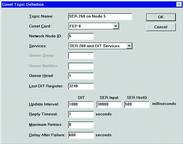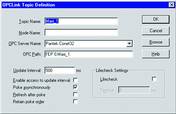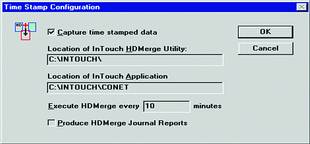
Gary Bradshaw is Director of Marketing at Pantek, UK and has extensive experience in industrial monitoring and control systems, alarm annunciation, sequential events recording and other related electronic instrumentation. Conet OPC Server is available locally in South Africa from Omniflex.
Pantek is primarily a Wonderware distributor and for years has sold Omniflex products, developed and manufactured in South Africa, over in the UK, with a great deal of success. The brand (formerly Conlog) has a very good name due to the quality and reliability of the product and there are a number of industries that have standardised on the range because of this. In particular, the Conet local area network products have taken off in the UK, due to the low cost of connectivity, their ability to run on long cables, even on existing poor quality lines and because they interface well with Wonderware applications.

The initial product range comprised simple 'black box' telemetry devices that could multiplex digitals and analogs onto a twisted pair and transmit these up to 10 km. The company supplied these alongside the Omni-16 annunciator range to the power generation, petrochemical and general industries where they are still operational on the original networks. One of the features of the Conet LAN is that newer products are backward compatible so when the system is expanded by adding newer devices, they are able to communicate with each other instantly.
Products introduced after the original 'Squeezer' telemetry black box, were the SER 260 sequential events recorder and the Maxiflex RTU/Remote I/O system, both of which have built-in Conet capability as standard.

As a distributor, Pantek obviously looks for product ranges that require the least amount of engineering effort and the Omniflex range has proved itself over and over again over a period of nearly 30 years. In this scenario the company can focus on client and systems development, knowing that the front-end products will work first time and run reliably for years.
Over the years, Pantek has interfaced the Conet products to Wonderware InTouch and other scada packages and, in many cases, had to write specific drivers for these. Many of the Omniflex products time-stamp digital events at source and pass these up to the scada where they are used for displays and alarms etc. Writing drivers to accommodate time-stamped data is probably the area that has given the most trouble over the years as Omniflex were doing it years before it became fashionable. To overcome this Pantek has written an OPC (OLE for Process Control) server for Conet which runs under Microsoft Windows NT and allows Wonderware Applications in particular, plus other Windows applications access to data from Omniflex devices on a Conet Local Area Network (LAN). The OPC server interfaces with the different products (nodes) on the Conet LAN via any number of Conet interface cards plugged into the PC on which the Server is installed. Therefore, each Conet LAN accommodates up to 126 devices and one can read several LANs in the same PC.

The Conet OPC server was developed using the OPC server toolkit from FactorySoft and DDE server toolkit from Wonderware Corporation for use with OPC client via OPCLink IO server. Conversations with the InTouch scada take advantage of Wonderware's Fast DDE data format but the server also provides data to other Windows OPC client applications.
While it was developed for Wonderware, the Conet OPC server works with most scada applications on the market and basically provides Pantek with standardised access to factory floor data from the Conet products which could be anywhere in the plant, performing different tasks and reading different data. This has totally eliminated the need for Pantek or anyone else, to write specific drivers every time interfacing with a new package is needed.
The Conet OPC server acts as a central gateway for client applications on the LAN, (eg InTouch, MS Excel, MS Sequel Server) by translating the requests from these applications into the Conet protocol and by converting returned Conet data into the application's format. Based on OLE and COM/DCOM standards within Windows, OPC functions across LANs and WANs transparently to the user.
The advantage is that Pantek's clients with existing Conet networks that have been running quietly 24 hours a day for decades can now link all this information to their control systems and management systems through the OPC server without even shutting down the Conet LANs. This is a major advantage for Pantek and for its clients as Pantek can build the application off-line and simply switch it on when it is ready. In its simplest form Pantek can set up the Conet OPC server to populate a Microsoft SQL Server database with plant data from the Conet LAN which then serves data to InTouch and the Management environment eg Excel PCs and other databases. Pantek says that this is the quickest and most manageable model for upgrading existing clients and indeed for new projects and enables scada, MES, MIS and other layers in the organisation to access data simultaneously for their own uses. However, it is possible for any client application to access data directly from the Conet device. For example the following formula in an Excel spreadsheet: =CONET|'SER at Node 2'!'DIT 890.7' will return the value of the eighth bit of register 890 on topic 'SER at Node 2'.
A number of features have been included into the OPC Server. One of these is the ability to update the date and time of all Conet products on the LAN with the current date and time from the PC clock. Another feature is the ability to optimise incoming traffic from the SER 260 sequential events recorder which itself can record and time-stamp up to 4096 digitals per millisecond. Special logic has been implemented in the OPC server, to prevent the client (eg InTouch) from being updated with 'old' data arriving via the history queues. The server also provides powerful error reporting which is logged for use by the client applications. The OPC server has leveraged Pantek's business well where it is able to provide true value added service to clients with older Conet installations, thus preserving their investments and tapping into a hidden data resource that might have been lying locked up for years.
Where only a few had access to the information, it can be made available to whoever needs to see it for total efficiency management in the company. At the same time the company has the ability to offer very cost-effective greenfields solutions to new clients who see the benefits of simple connectivity and low-cost implementation.
| Tel: | +27 31 207 7466 |
| Email: | [email protected] |
| www: | www.omniflex.com |
| Articles: | More information and articles about Omniflex Remote Monitoring Specialists |

© Technews Publishing (Pty) Ltd | All Rights Reserved